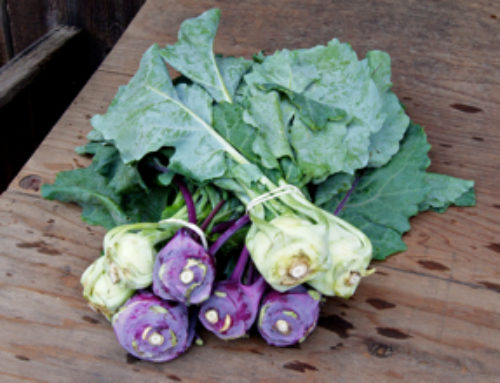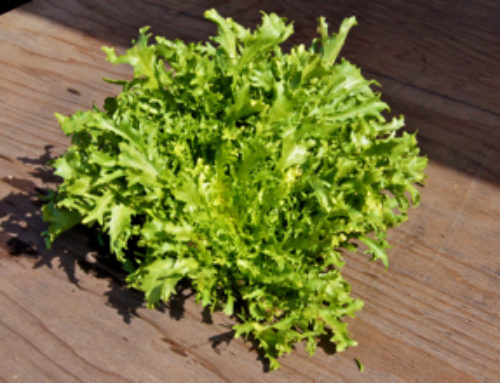Before I get started on this week’s blog, I want to run an idea by you members. Do any of you guys ever just have questions about how to deal with something in your box? Something you get or have gotten that confounds you or that maybe you don’t even know what it is, and want to learn more so you can prepare and eat it? If so, drop me a line and ask away. No question is stupid (trust me on that). Besides, if you have a question, you’re probably not alone so speak up. I would be more than happy to answer (or try to!) here in this blog so you and everyone else can learn. Email me at deb@writerguy.com. Okay, on to the kale!
I’ve been a member of this CSA for what, going on 17 years now…? and this is the first time in memory that Tom’s grown curly kale, otherwise known as Winterbor. I’m so accustomed to the Red Russian and Lacinato (Dinosaur) kales that he’s grown for years; this took me by surprise. Tom will probably talk at some point about his choice to grow this new variety, but my job is to let you know how to cook with it! So I got myself a “pre-release” bunch from Luis at the Los Gatos Farmers Market in order to play with it and report back to you. Here’s the skinny.
The curly kale (aptly named… talk about ruffles!) is much milder in flavor as compared to Red Russian and Lacinato. Like the Red Russian though, it is especially sweet in wintertime, when the cold causes it to grow slowly and concentrate its sugars. As always, my first recommendation with a new leafy green is to just tear off a piece and chew it, see what it tastes like. Take your time and chew it well enough so that your saliva (and its helpful enzymes) kicks in to help break down the leaf so you can really taste its essence before swallowing. I think you’ll be pleasantly surprised.
So what can you do with curly kale? Pretty much anything you can do with other kales. Probably the only thing for which it isn’t well suited is chiffonading (slicing into thin ribbons), because the leaves are so curly you can’t really stack, roll and slice them. But that’s merely a technique for cutting greens into manageable pieces; if you have winterbor kale and want to use a kale recipe that calls for chiffonading, don’t throw up your hands! Just skip that step and tear the leaves into bite-sized pieces instead. That’s what I did when I made the massaged kale salad below.
Speaking of massaged kale salads, there is almost as much variety in making them as in making your more typical lettuce-based salads. In a regular lettuce salad, what do you do? You wash, dry, and tear up your greens; add other goodies like cut up, sliced, or grated other veggies; add things like fruit or cheese or nuts or mushrooms or sliced meats or crumbled bacon or (etc etc); then dress it with some dressing you’ve decided goes well with the combination of fixings you’ve chosen. Sometimes you just dress the plain greens — no “added goodies” at all. Well you know what? You can do the same thing with a kale salad. Just substitute massaged kale for some or all of the lettuce (yes, I’ve even massaged up a handful of kale and tossed it into a regular lettuce salad, instead of spinach leaves, to add that rich, dark-green color and contrast).
Sometimes I think it’s a misnomer to even call this a salad; it is equally also a side-dish (I would use it as a side dish of a meal anytime; just plunk it on the plate along with whatever else I’m serving). But “salad” is a convenient moniker, so we’ll call it that for convention’s sake. Here’s what I made with my curly kale this time around:
Massaged Winterbor Kale and Apple Salad
First, of course, comes the massaging part. [By the way, in this example, I’m making a salad based on one bunch of kale.] Strip the leaves off of the stems and tear them into pieces in a bowl large enough to contain them. Notice how they’re a kind of dusty, grey-green at the outset.
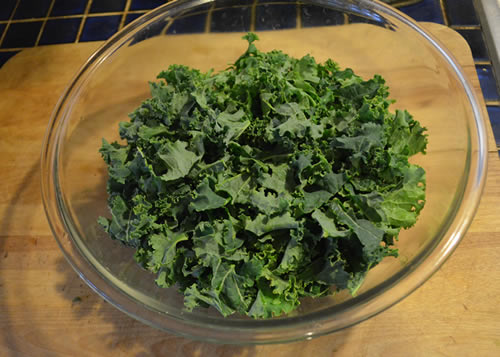
Now wash your hands, roll up your sleeves and start massaging! Squish, squeeze, mash; grab handfuls and roll them between your hands – however you want to do it. I like to add my salt during the massaging process as this aids in breaking down the cell walls of the leaves, softening them (just like when massaging cabbage for making sauerkraut), and lately I’ve found that it helps to partially massage the kale first, then sprinkle in the salt and continue to massage. The salt sticks better to the partially-massaged leaves, whereas if I salt them at the very beginning, it tends to fall down through to the bottom of the bowl. Some folks will say you can just leave the water from washing clinging to the leaves and the salt will stick to that, but I don’t like wet greens of any sort when making a salad – it just dilutes flavors in a way I don’t like. But you could of course drizzle a little oil on the leaves and the salt will stick to that if you like. Even messier, but what the hey – that would work too.
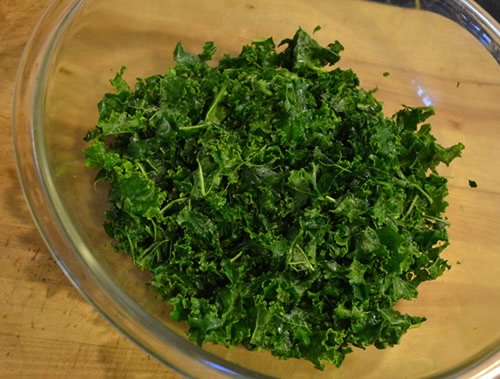
Notice how once you’ve massaged the kale the leaves turn a lovely dark, translucent emerald green, and are now much softer to the touch. The chlorophyl in the leaves will color your hands, but not stain; the green will wash off readily with soap and water, so not to worry.
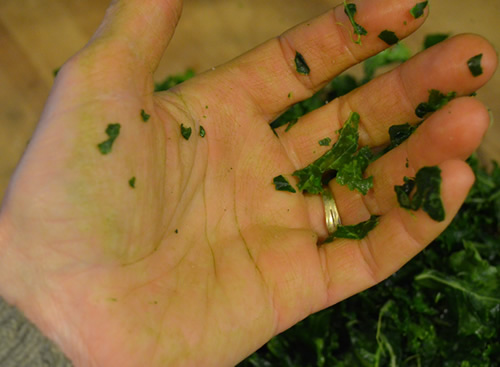
Now all’s left to do is add toppings and dress! Here I diced up and added one of the apples from the box, then threw in some dried cherries (you could just as easily use raisins or some other dried fruit if you like), then some toasted sunflower seeds (Rebecca got me on that kick; they add a little protein and a nice crunchy, contrasting texture to the softened kale).
[One thing I didn’t add but which is really nice in a salad like this is some macerated onion (sometimes I’m in a mood for onion, sometimes not). The maceration process cuts the sharpness of raw onion, and is very simple to do. Just thinly slice — red onion would be prettier but yellow’d be fine too — and immerse the slices in a small dish of a combination of cider vinegar and water. Let that sit 10 or 15 minutes while you’re doing other salad things, then drain, squeeze it out, and toss it into the salad.]
Since I’d chosen an apple theme, I made a cider-vinegar based dressing — even took measurements so I could pass ’em along (I usually never measure):
2 tbsp. cider vinegar (you could substitute balsamic or some other fruity vinegar if you like)
1 tsp. Dijon mustard
1/2 to 3/4 tsp honey
3 tbsp. grapeseed oil (a pretty green-hued oil that doesn’t have a strong flavor of its own; it’s not a “must” for this dressing by any means, it’s just what I used. You could easily substitute a different oil.)
>> don’t add salt, because you’ve already salted the kale
Whisk this all together in a small bowl with a fork, then pour over the salad and toss to coat. Lastly, grate in a little fresh parmesan cheese and crack in some black pepper and toss again to combine.
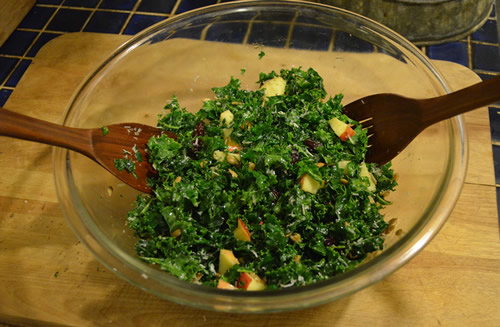
You can eat the salad right away, or make it ahead of time and eat it later. One of the really nice things about massaged kale salads is that they make great left-overs! As opposed to their delicate-hinied cousins, the leaf lettuce salads, which will wilt and get yukky if dressed too far ahead of time, the kale salads are robust and can be made one day, eaten the next… and even the day-after-next, and still be good to go.


